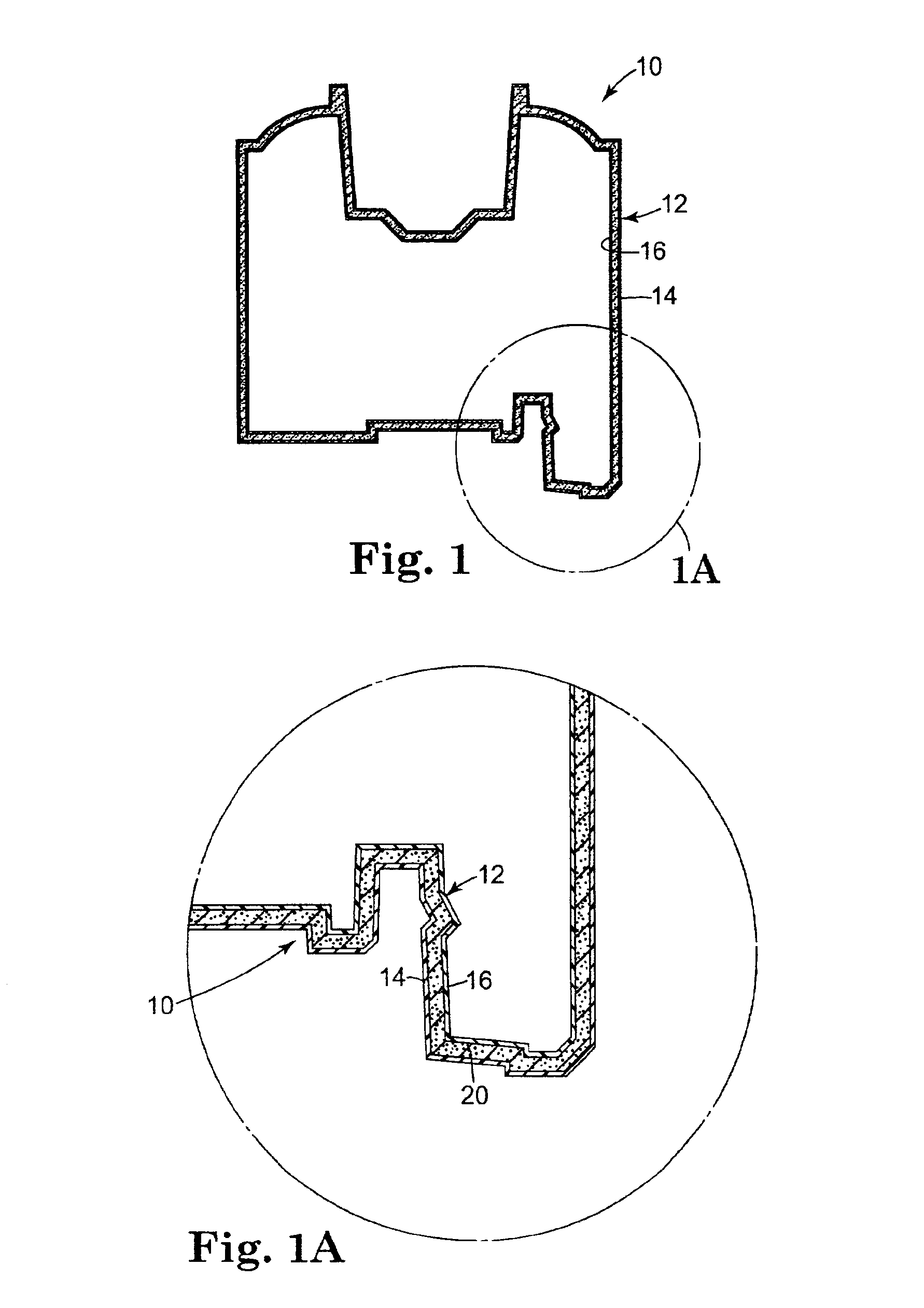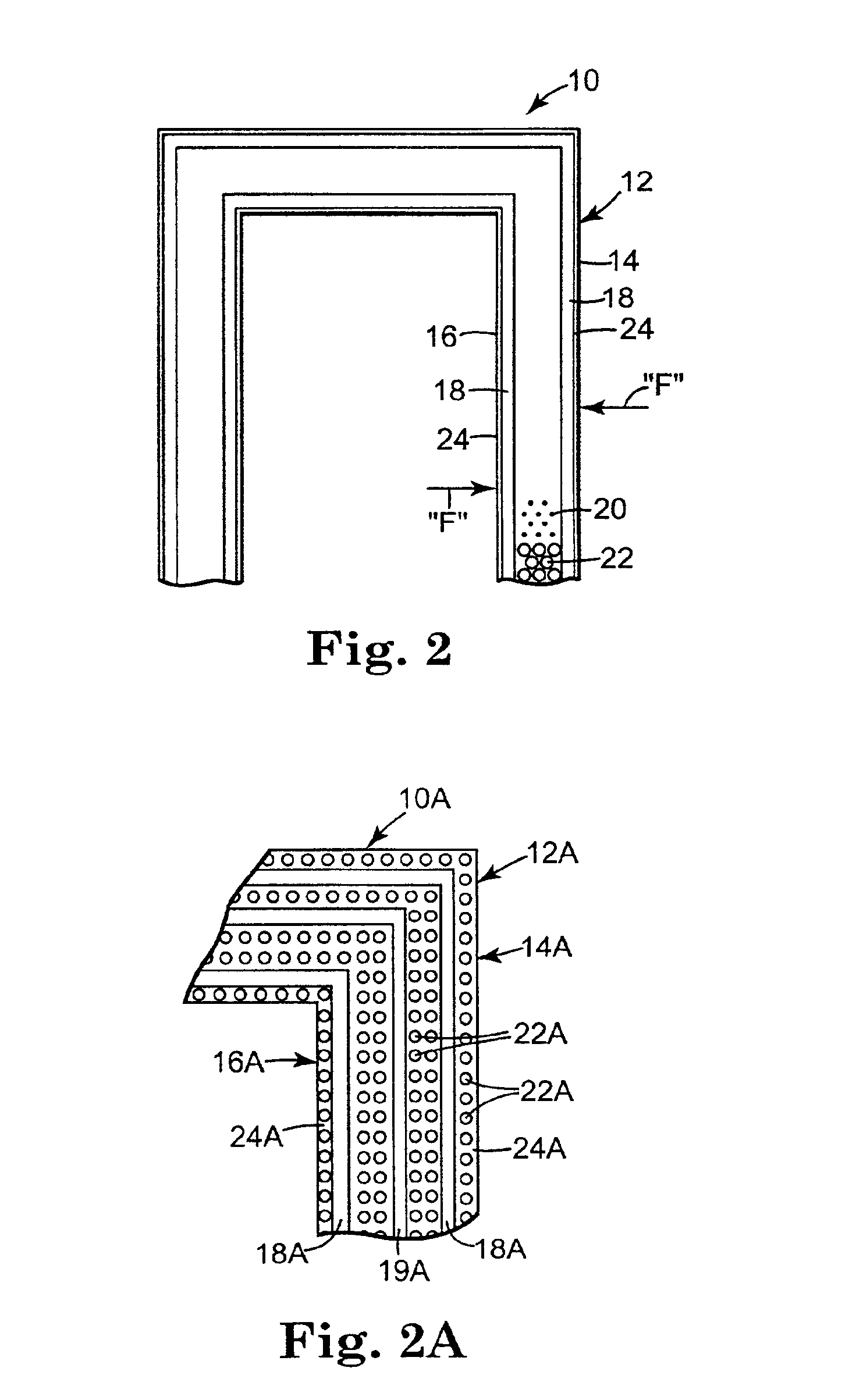Method of making a pultruded part with a reinforcing mat
a technology of reinforcing mats and pultruded parts, which is applied in the direction of manufacturing tools, buttons, other domestic objects, etc., can solve the problems of conventional mats, affecting the pultrusion process efficiency, and minimal transverse strength of pultruded parts
- Summary
- Abstract
- Description
- Claims
- Application Information
AI Technical Summary
Benefits of technology
Problems solved by technology
Method used
Image
Examples
example 1
Thermally Bonded Reinforcing Mat
A reinforcing mat, in a resin matrix, that provides high transverse strength on the exterior or interior surface of a pultruded part such as a sash stile or rail, or a pultruded frame head, sill, or jamb, or other products outside the fenestration industry. The cross-section of the pultruded part is a matrix of thermosetting resin with longitudinal and other-reinforcing fibers in the interior of the parts profile thickness. A first mat layer accounts for about 0.010 inches of the thickness of the pultruded part, the longitudinal-reinforcing fiber area is about 0.030″ thick, and the opposite mat layer is also about 0.010″ thick. The longitudinal reinforcing fibers are oriented in the 0° direction. These longitudinal fibers are mostly 675-yield (about 675 yards per pound) glass reinforcing fibers.
The reinforcing mat is a multi-layered structure, with the longitudinal direction (e.g. the pull direction) designated as the 0°. A first layer includes a plur...
example 2
Polyester Stitched Reinforcing Mat
A reinforcing mat, in a resin matrix, that provides high transverse strength on the exterior or interior surface of a pultruded part such as a sash stile or rail, or a pultruded frame head, sill, or jamb, or other products outside the fenestration industry. The cross-section of the pultruded part is a matrix of thermosetting resin with longitudinal and other-reinforcing fibers in the interior of the parts profile thickness. A first mat layer accounts for about 0.010 inches of the thickness of the pultruded part, the longitudinal-reinforcing fiber area is about 0.030″ thick, and the opposite mat layer is also about 0.010″ thick. The longitudinal reinforcing fibers are oriented in the 0° direction. These longitudinal fibers are mostly 675-yield (about 675 yards per pound) glass reinforcing fibers.
The reinforcing mat is a multi-layered structure, with the longitudinal direction (e.g. the pull direction) designated as the 0°. A first layer includes a pl...
example 3
Glass Fiber Stitched Reinforcing Mat
A reinforcing mat, in a resin matrix, that provides high transverse strength on the exterior or interior surface of a pultruded part such as a sash stile or rail, or a pultruded frame head, sill, or jamb, or other products outside the fenestration industry. The cross-section of the pultruded part is a matrix of thermosetting resin with longitudinal and other-reinforcing fibers in the interior of the parts profile thickness. A first mat layer accounts for about 0.010 inches of the thickness of the pultruded part, the longitudinal-reinforcing fiber area is about 0.030″ thick, and the opposite mat layer is also about 0.010″ thick. The longitudinal reinforcing fibers are oriented in the 0° direction. These longitudinal fibers are mostly 675-yield (about 675 yards per pound) glass reinforcing fibers.
The reinforcing mat is a multi-layered structure, with the longitudinal direction (e.g. the pull direction) designated as the 0°. A first layer includes a ...
PUM
| Property | Measurement | Unit |
|---|---|---|
| thickness | aaaaa | aaaaa |
| thickness | aaaaa | aaaaa |
| weight percent | aaaaa | aaaaa |
Abstract
Description
Claims
Application Information
 Login to View More
Login to View More - R&D
- Intellectual Property
- Life Sciences
- Materials
- Tech Scout
- Unparalleled Data Quality
- Higher Quality Content
- 60% Fewer Hallucinations
Browse by: Latest US Patents, China's latest patents, Technical Efficacy Thesaurus, Application Domain, Technology Topic, Popular Technical Reports.
© 2025 PatSnap. All rights reserved.Legal|Privacy policy|Modern Slavery Act Transparency Statement|Sitemap|About US| Contact US: help@patsnap.com



